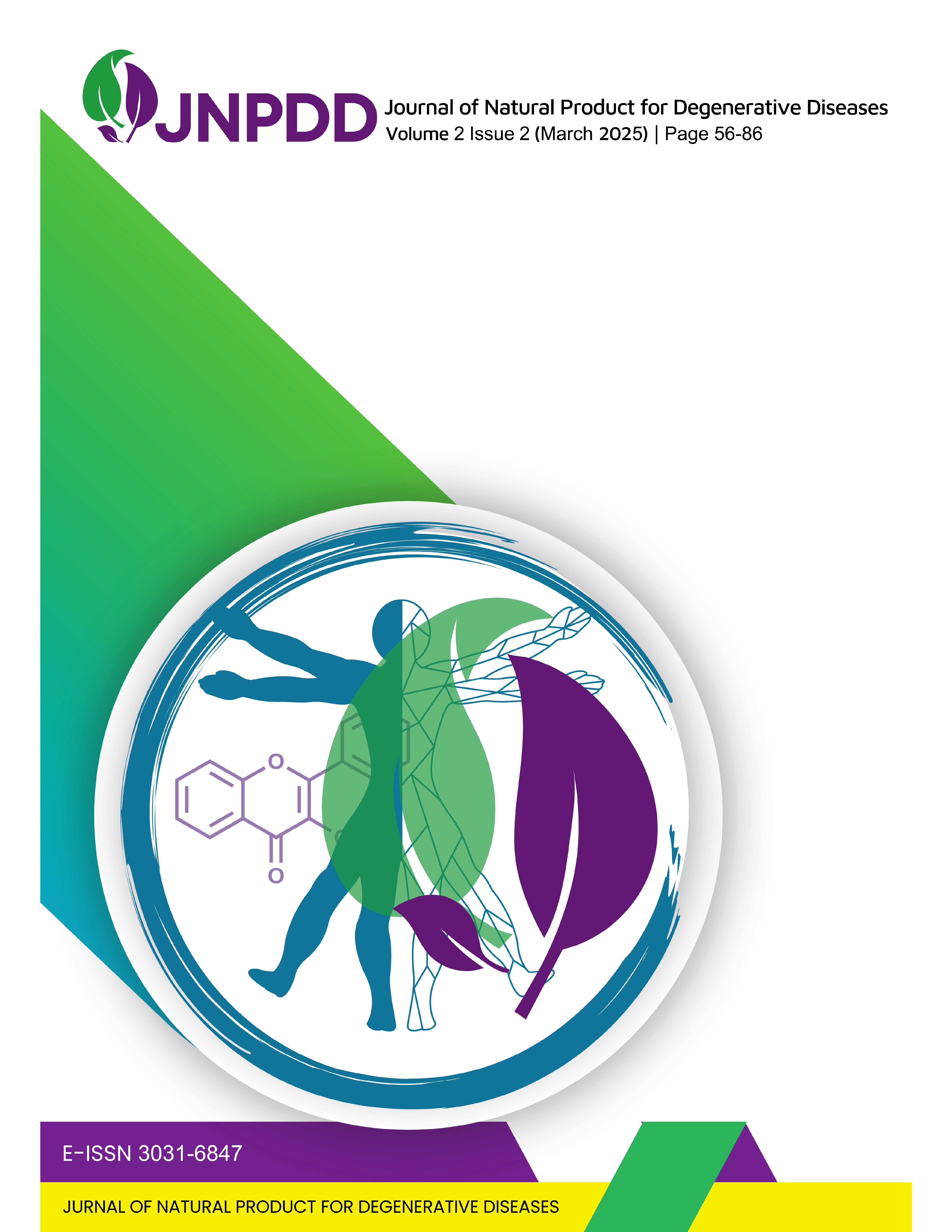Development and Optimization of Facial Wash Gel with Okra Fruit (Abelmoschus esculentus) Extract: a Study on HPMC Concentration Variations
Abstract views: 21 | PDF downloads: 6
Abstract
The stability of facial wash gel formulations is influenced by the concentration of Hydroxypropyl Methylcellulose (HPMC), which plays a crucial role in determining viscosity, homogeneity, spreadability, and foam stability. This study aimed to evaluate and optimize the physical stability of facial wash gel containing okra extract 3% (Abelmoschus esculentus (L.) Moench) by varying HPMC concentrations (1, 1.5, and 2%). The formulations were assessed for homogeneity, syneresis, pH stability, viscosity, spreadability, and foam stability over a 28-day storage period at room temperature (25°C). Statistical analysis was performed using SPSS version 27, including Shapiro-Wilk normality test, Levene’s test for homogeneity, One-Way ANOVA, and Tukey’s post-hoc test to determine significant differences among formulations. The results showed that HPMC concentration significantly influenced gel stability. F1 (1% HPMC) exhibited syneresis, excessive spreadability, and lower viscosity, indicating poor structural integrity. F2 (1.5% HPMC) maintained moderate stability but showed significant changes in spreadability over time. F3 (2% HPMC) demonstrated the best stability with optimal viscosity, minimal syneresis, controlled spreadability, and consistent foam formation. pH values for all formulations remained within the acceptable range (4.5–7.8, SNI 16-4380-1996). Foam stability (60–70%) met regulatory standards (SNI 16-4085-1996), with higher HPMC concentrations contributing to increased foam retention. The study confirms that HPMC concentration is a key determinant of gel stability. F3 (2% HPMC) exhibited the most stable formulation, balancing viscosity, spreadability, and foam stability, making it the optimal formulation for facial wash gel development. These findings highlight the importance of gelling agent optimization in cosmetic formulations, ensuring both product stability and consumer acceptability.
References
A. Selwyn and S. Govindaraj, “Study of plant-based cosmeceuticals and skin care,” South African Journal of Botany, vol. 158, pp. 429–442, Jul. 2023, doi: 10.1016/j.sajb.2023.05.039.
Y. Y. S. Rahayu, T. Araki, and D. Rosleine, “Factors affecting the use of herbal medicines in the universal health coverage system in Indonesia,” J Ethnopharmacol, vol. 260, p. 112974, Oct. 2020, doi: 10.1016/j.jep.2020.112974.
P. Kumar, N. Karam, and D. Choudhury, “Assessment of the Phytochemical Constituents and Metabolites in the Medicinal Plants and Herbal Medicine Used in the Treatment and Management of Skin Diseases,” 2024, pp. 1–41. doi: 10.1007/978-3-031-21973-3_21-1.
V. B. Patravale and S. D. Mandawgade, “Novel cosmetic delivery systems: an application update,” Int J Cosmet Sci, vol. 30, no. 1, pp. 19–33, Feb. 2008, doi: 10.1111/j.1468-2494.2008.00416.x.
N. N. Fajriyah et al., “Soursop Leaf Extract Gel: A Promising Solution for Skin Bacterial Infections,” 2024, pp. 1166–1175. doi: 10.2991/978-2-38476-273-6_120.
N. N. Fajriyah, M. Muhtadi, F. N. Rosyidand, and E. Mugiyanto, “Characterization of nano-hydrogel chitosan-annona muricata extract by using ionic gelation,” 2024, p. 020008. doi: 10.1063/5.0198874.
A. Filimon, M. D. Onofrei, A. Bargan, I. Stoica, and S. Dunca, “Bioactive Materials Based on Hydroxypropyl Methylcellulose and Silver Nanoparticles: Structural-Morphological Characterization and Antimicrobial Testing,” Polymers (Basel), vol. 15, no. 7, p. 1625, Mar. 2023, doi: 10.3390/polym15071625.
R. Agregán et al., “Biological activity and development of functional foods fortified with okra ( Abelmoschus esculentus ),” Crit Rev Food Sci Nutr, vol. 63, no. 23, pp. 6018–6033, Sep. 2023, doi: 10.1080/10408398.2022.2026874.
H. Sipahi et al., “A comprehensive study to evaluate the wound healing potential of okra (Abelmoschus esculentus) fruit,” J Ethnopharmacol, vol. 287, p. 114843, Apr. 2022, doi: 10.1016/j.jep.2021.114843.
K. Khatreja and D. Santhiya, “Physicochemical characterization of novel okra mucilage/hyaluronic acid-based oral disintegrating films for functional food applications,” Int J Biol Macromol, vol. 278, p. 134633, Oct. 2024, doi: 10.1016/j.ijbiomac.2024.134633.
Y. Gao, J. Tan, Y. Sang, J. Tang, X. Cai, and H. Xue, “Preparation, structure, and biological activities of the polysaccharides from fruits and vegetables: A review,” Food Biosci, vol. 54, p. 102909, Aug. 2023, doi: 10.1016/j.fbio.2023.102909.
B. Păcularu-Burada, A.-I. Cîrîc, and M. Begea, “Anti-Aging Effects of Flavonoids from Plant Extracts,” Foods, vol. 13, no. 15, p. 2441, Aug. 2024, doi: 10.3390/foods13152441.
M. Kumar, S. Chopra, S. Mahmood, M. A. Mirza, and A. Bhatia, “Formulation, Optimization, and Evaluation of Non-Propellent Foam-Based Formulation for Burn Wounds Treatment,” J Pharm Sci, vol. 113, no. 9, pp. 2795–2807, Sep. 2024, doi: 10.1016/j.xphs.2024.07.004.
M. S. Qulub, W. Wirasti, and E. Mugiyanto, “Perbedaan aktivitas antioksidan ekstrak etanol daun, daging buah, dan biji mengkudu (Morinda citrifolia L.) dengan metode DPPH (1, 1–Diphenyl-2-picrylhydrazyl),” in Prosiding University Research Colloquium, 2019, pp. 454–462.
E. Mugiyanto and R. Fatmala, “Karakterisasi Simplisia Dan Ekstrak Anti Piretik Daun Dadap Serep (Erythrina Lithosperma Miq) Dari Kabupaten Pekalongan”.
A. P. Ratu and E. Mugiyanto, “Uji Toksisitas Daun Ketepeng (Cassia Alata L.), Kulit Buah Pisang Ambon (Musa Paradisiaca L. Var Sapientum) Dan Kulit Rimpang Kencur (Kaempferia Galanga Linn.) Dengan Metode Brine Shrimp Lethality Test (BSLT)”.
Y. W. Permadi and E. Mugiyanto, “Formulation And Evaluation Of Physical Properties Of Anti Dandruff Shampoo Extract,” 62 Jurnal Farmasi Sains Dan Praktis, vol. 4, no. 2, pp. 62–66, 2018.
A. Yulyana, C. Amin, P. Simanjuntak, S. Abdillah, A. Rohman, and E. Mugiyanto, “Assessing the Antimetabolite Activity of Anthocyanins in Cantigi Fruits from Two Conservation Sites in Indonesia,” Indonesian Journal of Pharmacy, Sep. 2023, doi: 10.22146/ijp.8788.
H. Shah, A. Jain, G. Laghate, and D. Prabhudesai, “Pharmaceutical excipients,” in Remington, Elsevier, 2021, pp. 633–643. doi: 10.1016/B978-0-12-820007-0.00032-5.
S. Widyaningsih, M. Chasani, H. Diastuti, and Novayanti, “Formulation of Antibacterial Liquid Soap from Nyamplung Seed Oil ( Calophyllum inophyllum L) with Addition of Curcuma heyneana and its Activity Test on Staphylococcus aureus,” IOP Conf Ser Mater Sci Eng, vol. 349, p. 012062, Apr. 2018, doi: 10.1088/1757-899X/349/1/012062.
A. O. W. Kaya, M. L. Wattimena, E. E. E. M. Nanlohy, and S. Lewerissa, “PENGARUH PERBANDINGAN DAN KONSENTRASI BAHAN PEMBENTUK GEL TERHADAP SIFAT FISIKO-KIMIA GEL KOMBINASI KARAGINAN DAN PATI SAGU,” INASUA: Jurnal Teknologi Hasil Perikanan, vol. 2, no. 1, pp. 100–107, Jan. 2022, doi: 10.30598/jinasua.2022.2.1.100.
U. Waznah, N. Mufrodah, W. Wirasti, and E. Mugiyanto, “Evaluation of the mucolytic activity of ethanol extract of Temu Ireng (Curcuma aeruginosa Roxb.),” Farmasains : Jurnal Farmasi dan Ilmu Kesehatan, vol. 9, no. 2, pp. 59–68, Dec. 2024, doi: 10.22219/farmasains.v9i2.34760.
N. N. Fajriyah et al., “Topical nano hydrogel formulation of annona muricata extract enrich with zinc for improved therapy design and evaluation,” 2023, p. 020141. doi: 10.1063/5.0120738.
Tri Putri Wahyuni and Atyka Trianisa, “Bioactivity and Benefits of the Okra Plant (Abelmoschus Esculentus (L.) Moench.) : Literature Review,” Science Get Journal, vol. 1, no. 3, pp. 30–41, Aug. 2024, doi: 10.69855/science.v1i3.48.
A. A. Elshafy, M. Abou-Ellail, and M. El-Sayed, “Metabolic profiling of bioactive phytochemicals of two okra genotypes and their F1 and backcrosses,” International Journal of Vegetable Science, vol. 30, no. 2, pp. 198–224, Mar. 2024, doi: 10.1080/19315260.2024.2354773.
P. L. Tan et al., “Formulation and Physicochemical Evaluation of Green Cosmeceutical Herbal Face Cream Containing Standardized Mangosteen Peel Extract,” Cosmetics, vol. 9, no. 3, p. 46, Apr. 2022, doi: 10.3390/cosmetics9030046.
S. Banerjee and S. Bhattacharya, “Compressive textural attributes, opacity and syneresis of gels prepared from gellan, agar and their mixtures,” J Food Eng, vol. 102, no. 3, pp. 287–292, Feb. 2011, doi: 10.1016/j.jfoodeng.2010.08.025.
L. Zhang et al., “Rheological and gel properties of hydroxypropyl methylcellulose/hydroxypropyl starch blends,” Colloid Polym Sci, vol. 293, no. 1, pp. 229–237, Jan. 2015, doi: 10.1007/s00396-014-3407-5.
A. Garg, R. Sharma, P. Dey, and A. Kumar, “Food auto-oxidation: An overview,” in Antioxidants Effects in Health, Elsevier, 2022, pp. 43–68. doi: 10.1016/B978-0-12-819096-8.00013-6.
Wahyuddin Jumardin, Sirajul Firdaus, and Andi Ulfiana Utari, “Formulasi dan Uji Aktivitas Antibakteri Sediaan Gel Facial Wash Ekstrak Etanol Daun Belimbing Wuluh (Averrhoa Bilimbi L.) Terhadap Pertumbuhan Propionibacterium Acnes Penyebab Jerawat,” INHEALTH : INDONESIAN HEALTH JOURNAL, vol. 2, no. 2, Aug. 2023, doi: 10.56314/inhealth.v2i2.156.
P. Ruenraroengsak and A. T. Florence, “The diffusion of latex nanospheres and the effective (microscopic) viscosity of HPMC gels,” Int J Pharm, vol. 298, no. 2, pp. 361–366, Jul. 2005, doi: 10.1016/j.ijpharm.2005.01.044.
S. C. Joshi, “Sol-Gel Behavior of Hydroxypropyl Methylcellulose (HPMC) in Ionic Media Including Drug Release,” Materials, vol. 4, no. 10, pp. 1861–1905, Oct. 2011, doi: 10.3390/ma4101861.
Evi Marlina, Naelaz Zukhruf Wakhidatul Kiromah, and Titi Pudji Rahayu, “FORMULASI SEDIAAN ANTIOKSIDAN FACIAL WASH EKSTRAK METANOL DAUN GANITRI (Elaeocarpus ganitrus Roxb.) DENGAN VARIASI SODIUM LAURIL SULFAT SEBAGAI SURFAKTAN,” Jurnal Ilmiah Manuntung, vol. 8, no. 1, pp. 181–190, May 2022, doi: 10.51352/jim.v8i1.599.
M. Buzzacchi, P. Schmiedel, and W. von Rybinski, “Dynamic surface tension of surfactant systems and its relation to foam formation and liquid film drainage on solid surfaces,” Colloids Surf A Physicochem Eng Asp, vol. 273, no. 1–3, pp. 47–54, Feb. 2006, doi: 10.1016/j.colsurfa.2005.06.074.
N. Jain, R. Jain, V. Jain, and S. Jain, “A review on: Abelmoschus esculentus,” Pharmacia, vol. 1, no. 3, pp. 84–89, 2012.
M. A. M. Abdel-Razek, M. F. Abdelwahab, U. R. Abdelmohsen, and A. N. E. Hamed, “A Review: Pharmacological Activity and Phytochemical Profile of Abelmoschus esculentus (2010–2022),” RSC Adv, vol. 13, no. 22, pp. 15280–15294, 2023, doi: 10.1039/D3RA01367G.
Y. Zhou, X. Jia, J. Shi, Y. Xu, L. Jing, and L. Jia, “Two New Pentacyclic Triterpenes from Abelmoschus esculentus,” Helv Chim Acta, vol. 96, no. 3, pp. 533–537, Mar. 2013, doi: 10.1002/hlca.201200275.
N. W. G. Young, “Emulsifiers and stabilisers,” in Fats in Food Technology 2e, Wiley, 2014, pp. 253–287. doi: 10.1002/9781118788745.ch7.
S. Mizrahi, “Syneresis in food gels and its implications for food quality,” in Chemical Deterioration and Physical Instability of Food and Beverages, Elsevier, 2010, pp. 324–348. doi: 10.1533/9781845699260.2.324.
F. Tian, S. Baldursdottir, and J. Rantanen, “Effects of Polymer Additives on the Crystallization of Hydrates: A Molecular-Level Modulation,” Mol Pharm, vol. 6, no. 1, pp. 202–210, Feb. 2009, doi: 10.1021/mp800142z.
L. G. M. B. Becking, I. R. Kaplan, and D. Moore, “Limits of the Natural Environment in Terms of pH and Oxidation-Reduction Potentials,” J Geol, vol. 68, no. 3, pp. 243–284, May 1960, doi: 10.1086/626659.
D. R. Kryscio et al., “Spreadability Measurements to Assess Structural Equivalence (Q3) of Topical Formulations—A Technical Note,” AAPS PharmSciTech, vol. 9, no. 1, pp. 84–86, Mar. 2008, doi: 10.1208/s12249-007-9009-5.




